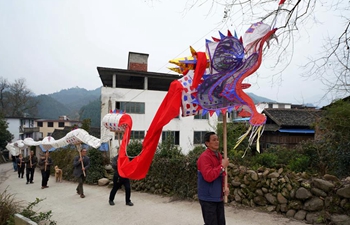NEW DELHI, Jan. 30 (Xinhua) -- Swine flu scare has gripped the Indian capital city as 11 suspected deaths and more than 500 cases have been reported over the past one month.
According to a report released by the Integrated Disease Surveillance Programme, which works under the country's Ministry of Health and Family Welfare, Delhi has witnessed an alarming rise in the number of swine flu cases this year, with 532 people diagnosed with the disease so far at various hospitals.
This is far more than the 205 cases reported during entire 2018, the report said.
Among the 11 dead, eight belonged to Delhi while the rest three came from other states. The city has witnessed 173 fresh cases of influenza in the last six days.
"There are 15 confirmed cases of swine flu in our hospital, of which eight patients have died. All eight were from Delhi," English daily The Indian Express quoted Ram Manohar Lohia (RML) Hospital spokesperson Smriti Tiwari. RML is one of the hospitals designated by the centre government for treating the disease.
Another leading hospital in the city, the Safdarjung Hospital confirmed 18 swine flu cases and three deaths. "Around 9-10 patients were admitted in the hospital. All of them are stable and a few have been discharged," All India Institute of Medical Sciences(AIIMS) Medical Superintendent D.K. Sharma reportedly said.
According to the newspaper report, the spread of the disease has kept the city's schools on alert too.
After a child tested positive for swine flu at the Sardar Patel School, the school's management got the school fumigated and asked students from nursery to grade four to stay at home till Feb. 4. Other schools have sent out advisories to parents concerning the spread of the disease.
The country's former defence minister George Fernandes had died of swine on Tuesday.
Swine flu is said to be a contagious respiratory disease caused by "Type A" strains of H1N1 virus. The virus enters the body through inhalation of contaminated droplets or is transferred from a contaminated surface to the eyes, nose or mouth of a person.
The initial symptoms of the disease are fever, cough, headache, muscle and joint pain, sore throat, running nose, and sometimes vomiting of diarrhea.













